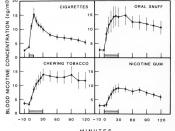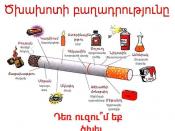Studies of ex-smokers show that their risk of dying from smoking-related disease decreases with each year
of non smoking. Encouraged by such evidence, more than 40 million people in the U.S. quit smoking in
the year following the 1964 surgeon general's report. The proportion of males who smoke decreased from
more than 60 percent to about 25 percent; however, the percentage of women who smoke cigarettes
increased. Smoking also became more prevalent among young adults, with about 29 percent of high
school seniors admitting to smoking in 1975; but by 1987 this proportion decreased to 18.7 percent.
There are programs that exist to help smokers quit. Some involve group support, whereas others use
aversive techniques in which participants smoke many cigarettes rapidly to the point of becoming sick of
them.
More than 30 million persons in the U.S. say that they would like to quit smoking but cannot.
One hypothesis to explain this problem is that the smoker craves the effect of the nicotine in the smoke.
In
a 1988 report, the surgeon general declared nicotine to be an addictive drug comparable to other addictive
substances in its ability to induce dependence. The report also called the monetary and human costs far
greater than those attributable to cocaine, alcohol, or heroin.
Attempts to help persons quit smoking through counseling, participation in support groups, and, for those
with a strong physical dependence on nicotine, substitution of chewing gum containing nicotine to lessen
withdrawal symptoms.


